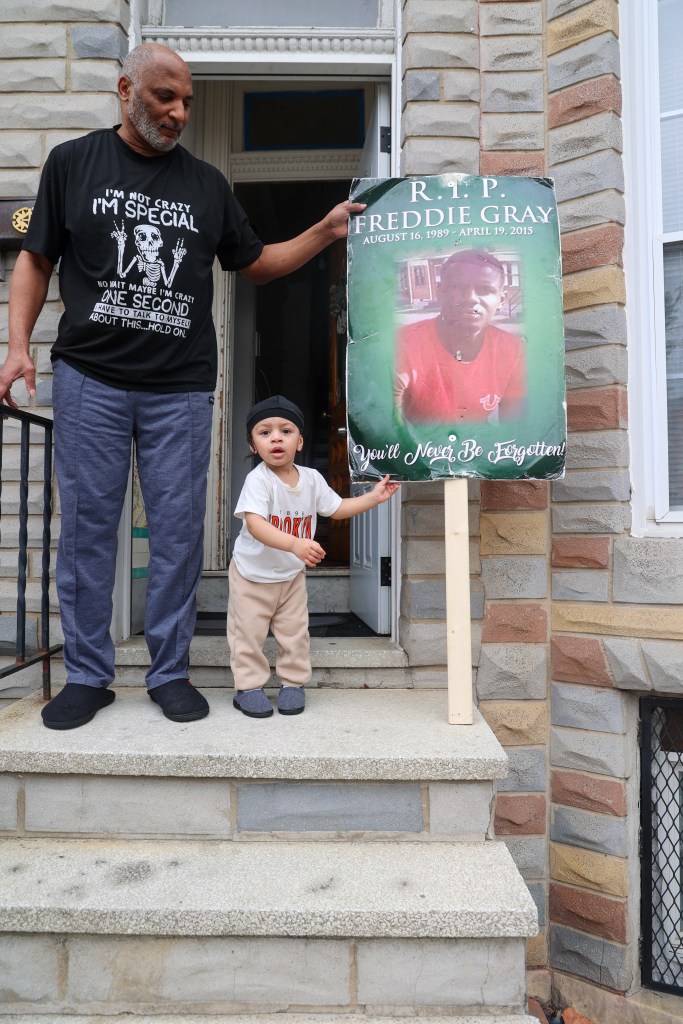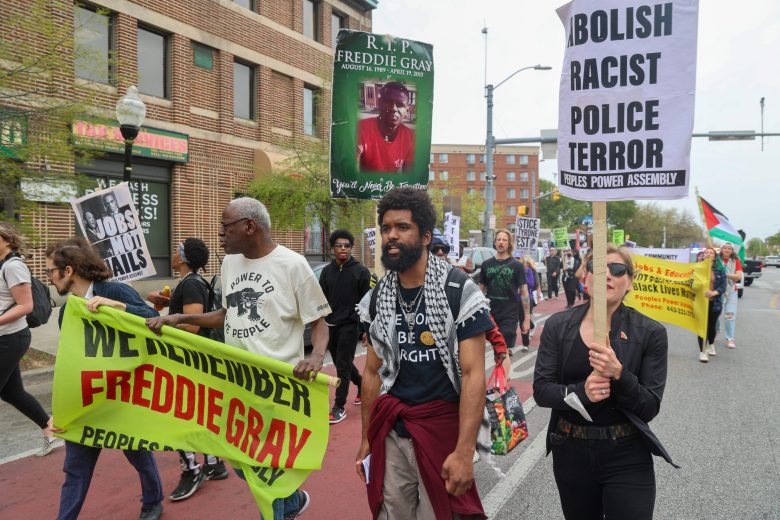On Saturday, April 19, Baltimore marked ten years to the day since Freddie Gray died from injuries inflicted in police custody through protests, art exhibits, and community gatherings — to remember Gray’s death, the subsequent Baltimore Uprising, and to renew calls for justice against what organizers called “ten years of broken promises.”
About three dozen people gathered outside the Penn-North Metro station — steps from where Gray was chased by police in 2015 — to mourn his death and denounce ongoing police brutality and racism.
The event, organized by the People’s Power Assembly, began at 1 p.m. with a speak-out. Protesters then marched down North Avenue toward Mondawmin Mall, retracing key locations from the Uprising. Participants chanted “No Justice, No Peace” and held signs reading “We Remember Freddie Gray,” “Cell Block for Killer Cops,” and “Jobs Not Police Killings.” Half a dozen police vehicles followed with lights flashing.
“It’s been ten damn years and zero fucking progress,” said PPA member Joyce Butler. “The people who did it, they got away with it. Everybody in Baltimore needs to be out here.”
Gray was 25 when police chased and tackled him on April 12, 2015. Cell phone video shows officers dragging him, screaming, into a police van. By the time the van reached the Western District station, Gray was unconscious and his spine severed. He died in a hospital bed seven days later, sparking nearly two weeks of mass protests remembered as the Baltimore Uprising.
No officers were convicted in his death, but many of the hundreds arrested during subsequent protests faced severe charges and bail as high as $500,000. Baltimore City paid Gray’s family $6.4 million to settle a wrongful death lawsuit. The Sandtown-Winchester neighborhood where Gray lived has remained disinvested and blighted. Many local residents say promised investment has failed to materialize.
A much larger crowd took part in a simultaneous “Hands Off” march and rally at City Hall, part of a national day of action against the Trump administration. That protest — organized by the Party for Socialism and Liberation and allied groups — drew hundreds and culminated in a march through downtown, including to the Baltimore City Police Department Headquarters, where protestors chanted, “All night, all day, we will fight for Freddie Gray.”
“Freddie Gray’s murder at the hands of BPD was central to our march,” said Nic Koski, an organizer with Baltimore Artists Against Apartheid, which helped organize the protest. A speaker from PSL highlighted how many of the same issues that plagued the BPD in 2015 persist today — underscoring the urgent need to continue the fight until there is real justice for victims of police brutality.
At Penn-North, the Freddie Gray memorial rally consisted largely of longtime PPA members, though some local residents joined to listen and speak.
“It’s like a family member died when he passed away,” Amos Jones, a resident who joined the rally to share his memories of Gray, told Baltimore Beat. Jones said he had been Gray’s barber and remembered him as a kind person.
“It will never really be justice,” Jones said. “He lost his life… I just want him to rest in peace.”
“You’ll never forget about Freddie Gray,” Jones added. “His name is stamped in this city.”
PPA member and longtime activist Cortly “C.D.” Witherspoon said Gray’s death was a catalyst that exposed systemic injustice and galvanized a generation. He criticized efforts to criminalize Gray and the protests that followed, instead describing them as a symbol of resistance against state violence.
“Freddie Gray has risen in my son, in your sons and daughters who are involved in the fight for justice,” said Witherspoon, introducing his son, C.J. Witherspoon, now a teenager.
“Freddie Gray has risen in my son, in your sons and daughters who are involved in the fight for justice.”
Cortly “C.D.” Witherspoon
C.J. Witherspoon, who was just five when Gray was killed, recalled the moment he learned about Trayvon Martin — a 17-year-old whose killing by vigilante George Zimmerman sparked nationwide protests — and realized that his own life expectancy might be cut short.

“America presents itself as bold and beautiful, yet it allows young Black men and women to die like flies,” C.J. Witherspoon said.
In the lead-up to the anniversary, activists renewed criticism of Baltimore’s budget priorities. The city this year proposed increasing its police budget by $22 million, pushing it to over $600 million this next fiscal year.
Carrington Scott, a member of the PPA who works at The Walters Art Museum, connected Gray’s story to broader struggles for self-determination.
“The same systems that murdered Freddie Gray are used to terrorize Black and brown people here in Baltimore and around the world,” Scott said.
Later that evening, Rise Bmore, a free, annual evening of words and music honoring Freddie Gray, featured a conversation among local artists and activists, followed by a concert. The gathering included artwork by and about Tyrone West, who was killed by BPD and Morgan State University police in 2013.
West’s sister, Tawanda Jones, was in attendance. Jones is a tireless advocate who has held weekly vigils since her brother’s death to demand justice for victims of police brutality.
“We’ve come a long way, but we’ve still got a long way to go,” Jones told the Beat. “It breaks my heart that Freddie Gray had to die so young, and still, nothing’s really changed to keep us safe. But seeing some accountability in cases like George Floyd’s gives me hope we’re not fighting for nothing.”

